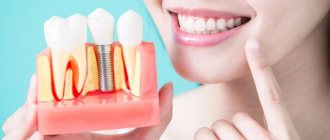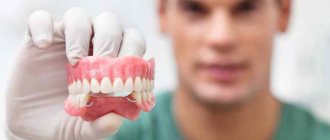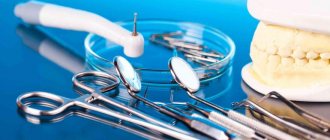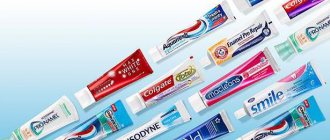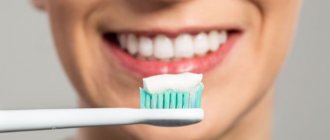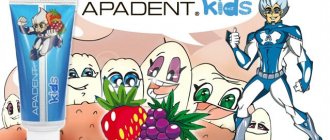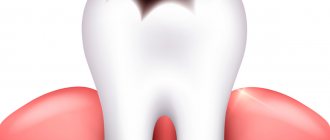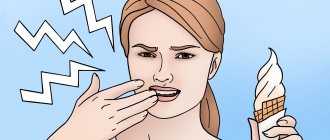Few of us know about the benefits and harms of fluoride contained in toothpaste, and how it affects the health of the entire human body.
Today, stores offer a wide selection of products with alternative elements that are effective and harmless for cleaning the mouth and teeth.
So what name should you choose for a toothpaste and why should you give up fluoride?
The best toothpaste without fluoride: composition
First, I would like to say a few words about fluoride-free toothpastes, which we conventionally classify as “outdated generation.” The fact is that they have a much lower price - in comparison with high-quality toothpastes based on real medical nano-hydroxyapatite (nHAP). We have already said above that the simplest toothpaste without fluoride will contain one of the following compounds:
- calcium glycerophosphate,
- calcium lactate,
- calcium pantothenate,
- calcium citrate,
- calcis®.
Important: the highest quality 1st generation fluoride-free toothpastes will contain the combination “calcium glycerophosphate + magnesium chloride” (this combination is patented as Mineralin ® and is used in ROCS toothpastes). The fact is that magnesium ions are able to activate the work of metal-dependent enzymes (acid and alkaline phosphatases), on which the efficiency of hydrolysis of calcium glycerophosphate into active calcium ions and phosphates depends.
In turn, SPLAT toothpastes contain a patented compound - Calcis ®, which is a complex of calcium compounds obtained from eggshells. It includes the water-soluble calcium dihydrogen phosphate, acetate, lactate, succinate, citrate and tartrate. However, neither Mineralin® nor Kaltsis® will make toothpaste without fluoride even close to the anti-caries effectiveness of toothpastes with fluoride or nano-hydroxyapatite. Therefore, they are best used only in children aged 0 to 6 years (and only in those who have the lowest risk of developing dental caries).
"PRESIDENT Unique". Italian
Preservatives, allergens, parabens, sodium lauryl sulfate, dyes and, of course, fluoride are absent in this case. The natural plant-based formula gently enhances the oral cavity's natural defenses.
Calcium and xylitol thoroughly clean the enamel. Soothing and antibacterial effects are guaranteed by bioextracts of echinacea, sage, and chamomile. Anethole and eucalyptus are selected in ideal proportions to create a sensation of delicate, fresh, long-lasting taste.
Recommended:
- as a prevention of caries, inflammatory processes in the gums;
- with a lack of calcium in the body;
- to strengthen gums, increase the shine of enamel;
- for accurate and effective plaque removal;
- to reduce sensitivity.
It is advisable to apply two or three times a day. The estimated cost of 100 ml packaging is 190 rubles.
The most modern and effective calcium compounds in fluoride-free toothpastes:
Of the compounds listed below, the palm can be given to two components: 1) synthetic medical nano-hydroxyapatite (nHAP), but subject to its correct concentration and correct particle size, 2) amorphous calcium phosphate associated with casein phosphopeptides (CPP-ACP). However, we will describe other compounds such as tricalcium phosphate (TCP) as well as Novamin®.
Medical nano-hydroxyapatite (nHAP) –
Hydroxyapatite (synonym: calcium phosphate hydroxide) is a stable and biocompatible calcium phosphate with low solubility, which is used in dentistry to remineralize teeth, reduce their sensitivity, and also for teeth whitening. It is almost exactly the substance that makes up tooth enamel. Medical nano-hydroxyapatite (nHAP) was developed in 1970 by the American agency NASA for astronauts to replenish the amount of minerals in their teeth and bones lost in conditions of weightlessness.
The first commercial toothpaste based on nHAP was developed in 1978 by the Japanese. Currently, the company's Apagard® and Apadent® toothpastes contain nano-mHAP ® (a patented form of nano-hydroxyapatite with a particle size of 8 to 40 nanometers). Now many similar products with hydroxyapatite have appeared in the world and in Russia, but as you will see below, most of them do not have a very good composition and low efficiency.
The effectiveness of hydroxyapatite paste is affected by:
- Hydroxyapatite particle size – hydroxyapatite in toothpastes comes in 2 varieties. The best option is nano-hydroxyapatite (nHAP), whose particles are up to 100 nanometers in size. But most often, toothpaste contains the most common hydroxyapatite (HAP), the particles of which are only micro-sized - up to 5-10 microns in diameter. However, the granulometric composition shows that only particles with a diameter of up to approximately 1-3 microns demonstrate reliable adhesion to the enamel surface, which cannot be said about larger hydroxyapatite particles (source).
Thus, the smaller the particle size, the easier they adhere to the surface of the enamel, the more significant a protective layer they will form on its surface, the more effective the remineralization of teeth will be, the higher the protection against caries will be, the faster tooth sensitivity will disappear, and also, the lower the rate of plaque formation will be. Thus, the particle size of hydroxyapatite is one of the most important criteria for its effectiveness in toothpaste (or mouthwash).nHAP particles up to 50 nanometers will penetrate as deeply as possible into demineralized areas of enamel, as well as micro-cracks - as if filling them. The fact is that tooth enamel consists of so-called enamel prisms (the distance between which is 50 nanometers), as well as interprismatic substance. When enamel demineralizes, it is the interprismatic substance that dissolves first of all, which is physiologically less mineralized. Therefore, nHAP particles up to 50 nanometers are able to penetrate deeply into areas of demineralization.
Microscopy of tooth enamel –
According to the scientific work “Evaluation of the effectiveness of long-term use of Apadent Total Care toothpaste containing medical nano-hydroxyapatite” (authors Makeeva, Polyakova, etc.), the use of paste with nano-hydroxyapatite particles from 8 to 40 nm led to complete remineralization of artificially created foci of dental demineralization enamel – in just 1-3 days. Such small particles are able to immediately penetrate deep into the enamel - even at the earliest stages of development of foci of demineralization.
Important: scientific work confirms that toothpastes with nano-hydroxyapatite particles of any size (even larger ones from 50 to 100 nanometers) have more significant remineralizing and anti-caries effects than toothpastes with non-nano-sized hydroxyapatite particles. This is due to the fact that hydroxyapatite nanoparticles have a higher degree of hydrophilicity and adhere to the enamel surface much more easily than micro-sized hydroxyapatite particles. Consequently, nano-hydroxyapatite will form a layer on the surface of the enamel, which will adhere more firmly to the tooth structure (24stoma.ru).
- Concentration of hydroxyapatite in toothpaste - scientific studies demonstrate that the effectiveness of hydroxyapatite has a clearly defined dependence on its concentration in the composition of the product (source). Experimental data show that increasing the concentration of hydroxyapatite from 1 to 10% led to an increase in the coverage area of the enamel surface from 10 to 32%. Thus, when using products with 1% hydroxyapatite, only 9.6% of the enamel was covered with a layer of hydroxyapatite; when using 5% hydroxyapatite – 13.4% of the enamel surface; when using 10% hydroxyapatite - 32% of the enamel surface area (see figure below).
Please note that these figures were obtained using micro -particles of hydroxyapatite, and not nano-particles. The scientific work mentioned above also discusses the fact that the smaller the hydroxyapatite particles, the better they will adhere to the enamel surface. Thus, if we use nano -hydroxyapatite, it will form a protective layer over a much larger area of the tooth surface (and the thickness of this layer will be greater) - than when using the same concentration of hydroxyapatite microparticles.
But let's move from numbers to real clinical effectiveness, and try to measure it. Scientific research will help us with this, allowing us to compare the effectiveness of tooth remineralization when using toothpastes with different compositions. The scientific study “Comparative effectiveness of hydroxyapatite and fluoride toothpaste for the prevention and remineralization of caries in children” (authors Bennett T. Amaechi, et al.) - shows the clinical effectiveness of 10% nano-hydroxyapatite at the level of fluoride toothpaste containing 500 ppm amino fluoride. Elmex fluoride children's toothpaste was used for comparison.
Other studies, such as King et al. (2006) - it was found that 10% nano-hydroxyapatite has only a slightly less remineralizing effect than toothpaste with 900 ppm sodium fluoride. We will take the average between these two studies as a basis, and will assume that 1400-1450 ppm of fluoride in toothpaste for adults is considered the standard for anti-caries protection. Thus, it turns out that the effective concentration of nano-hydroxyapatite should be at least 15-20% (with nHAP particle size from 50 to 100 nanometers). But for toothpastes with even smaller nHAP particles up to 50 nanometers, 2 times lower concentrations will be effective.
Important: our editors do not consider it possible to trust Russian toothpastes where the manufacturer simply states: “contains hydroxyapatite”, “contains nano-hydroxyapatite”, “contains hydroxyapatite particles of different sizes” - where neither the concentration nor the size of the particles are indicated at all. After all, if toothpaste contains ordinary hydroxyapatite (with a particle size of more than 1-3 microns, which do not stick to the enamel surface at all), then these particles can only serve as an abrasive. The correct concentration and particle size of hydroxyapatite are competitive advantages that set the product apart from the rest. And if the manufacturer refuses on principle to disclose this information, we draw quite logical conclusions. Therefore, it is best to buy those toothpastes where the manufacturer has clearly indicated that it uses nano-hydroxyapatite, as well as its concentration.
Tricalcium phosphate (TCP) –
Tricalcium phosphate (TCP) is indeed used in a number of fluoride-free toothpastes, but it is also much less effective than nHAP or CPP-ACP toothpastes. Therefore, it is better not to use toothpastes that contain only TCP, but you can use those that contain TCP in combination with hydroxyapatite (for example, Korean toothpaste Dr.EL Shirin Care).
Toothpastes containing tricalcium phosphate in combination with fluorides will have an even higher effect of remineralizing teeth. An example of such a paste is “ CLINPRO tooth cream ”, which contains tricalcium phosphate + 900 ppm sodium fluoride (produced by one of the most famous manufacturers of dental materials in the world - American).
NovaMin® (calcium and sodium phosphosilicate) –
NovaMin® is nothing more than “calcium sodium phosphosilicate”, which is used in toothpastes usually in a concentration of 5%. To put it in simple language, this is synthetic bioactive glass. When toothpaste comes into contact with saliva, calcium phosphate is deposited on the surface of the tooth enamel, which will gradually transform into hydroxyapatite crystals. But it must be said that calcium and sodium phosphosilicate is certainly less effective - in comparison with toothpastes based on nHAP or CPP-ACP.
The scientific study “In Situ Study to Confirm the Anticaries Potential of a Sodium Monofluorophosphate Dentifrice Containing Calcium Sodium Phosphosilicate” (authors Parkinson C., Siddiqi M.) suggests that adding calcium and sodium phosphosilicate to fluoride toothpastes did not increase and did not reduce the remineralizing potential of these toothpastes. Those. when adding 5% calcium and sodium phosphosilicate to the toothpaste with 1450 ppm fluoride, its effectiveness remained at the same level as if the toothpaste contained only 1450 ppm fluoride.
Recaldent™ (CPP–ACP) –
One of the best components for mineralization/remineralization of teeth, as well as reducing the risk of caries, is “Amorphous calcium phosphate bound to casein phosphopeptides” (CPP-ACP). This component is patented under the name Recaldent™, and its effectiveness is not inferior to toothpastes with nano-hydroxyapatite (nHAP). The only point is that products with CPP-ACP are usually produced only for applications on teeth, and not for brushing teeth. This is due to the fact that there are a number of studies showing that abrasives in toothpastes significantly reduce the deposition of amorphous calcium phosphate on the surface of tooth enamel.
An example of a product is fluoride-free dental gel “ GC Tooth Mousse ” (made in the USA). This drug contains the CPP-ACP complex as well as xylitol. The drug is used 1-2 times a day for applications on the teeth for 3-5 minutes (in adults and children over 3 years old). There is also an even more effective version of this product - the GC MI Paste Plus , but it already contains a combination of CPP-ACP and 900 ppm sodium fluoride. It should also be taken into account that products with the CPP-ACP complex can cause allergies in patients with milk protein intolerance, because Casein phosphopeptides are produced from cow's milk.
"ROCS" for adults" from a Russian manufacturer
Without using fluorine in the manufacture of the product, the creators achieve a high level of protection against harmful microbes with alternative components: xylitol, bromelain, magnesium chloride, calcium glycerophosphate. An increase in enamel acid resistance by 75% is one of the effects of using “ROCS” for adults.”
Plaque, which is the cause of dental diseases, is gently and accurately broken down, and the ability of bacteria to recreate new plaque is reduced. At the same time, the state of the microflora in the oral cavity is normalized.
As a result of the increased cleaning ability, there is no need for a high content of abrasive substances. This effect will be of interest to people with increased enamel abrasion.
And now the advantages suggested by users:
- sensitivity decreases;
- a huge assortment with different taste properties;
- excellent composition;
- excellent cleansing
and disadvantages:
- 200 rubles is not that cheap;
- uneconomical - too liquid, more flows onto the brush than required.
Fluoride-free toothpastes for children –
The enamel of children's teeth after they erupt contains very little calcium, i.e. is low-mineralized. Such porous enamel is very vulnerable to the effects of cariogenic bacteria in the oral cavity, and therefore children's teeth are especially quickly affected by caries. Toothpastes with fluoride protect teeth well from caries, but if you need to choose a toothpaste without fluoride, the latter must contain calcium. The best calcium compound in children's toothpastes is nano-hydroxyapatite.
In the ranking of fluoride-free toothpastes for children, in our opinion, the undisputed leader is the PRESIDENT line of Italian toothpastes. As you will see below, these pastes have an excellent composition and a very reasonable price. Also, in our opinion, SPLAT pastes are very interesting - due to the content of a complex of lactic enzymes that protect the mucous membrane from stomatitis and thrush.
Biorepair Kids toothpaste with strawberry flavor (from 0 to 6 years) –
- manufacturer: Italy,
- active substances – 15% nano-hydroxyapatite (MicroRepair®), zinc ions,
- abrasiveness – RDA 14.7,
- without fluoride, lauryl sulfate and parabens,
- 50 ml tube – from 350 to 400 rubles.
Comments: Biorepair Kids toothpaste contains 15% nano-hydroxyapatite (MicroRepair® particles, which, as we established above, range in size from 50 to 100 nanometers). In our opinion, this is the best fluoride-free children's toothpaste intended for children from 0 to 6 years old. In addition, the paste contains natural strawberry extract and is absolutely safe if swallowed. Zinc ions have a mild antibacterial effect. High degree of protection against caries and remineralizing effect (which will be even higher if you sometimes combine it with fluoride toothpaste). There is also a little bonus inside the package - a coloring book for children.
A slightly less effective analogue of this toothpaste is KAREX Kihder toothpaste (Germany), which contains micro-sized hydroxyapatite particles. The concentration of hydroxyapatite in this toothpaste is 10%, and its anti-caries effectiveness will be lower than that of Biorepair Kids.
Toothpaste ROCS PRO Kids “Wild Berries” (from 3 to 7 years) –
manufacturer – Russia,- active ingredients – hydroxyapatite, calcium glycerophosphate, magnesium chloride, 10% xylitol, honeysuckle extract,
- RDA - not specified,
- without fluoride, lauryl sulfate and parabens,
- the price for a 45 g tube is about 270 rubles.
Comments: a good toothpaste from a Russian manufacturer, which contains hydroxyapatite microparticles. In addition, the manufacturer cunningly indicated that a 50% hydroxyapatite suspension was used in the production of the toothpaste, but you should understand that this has nothing to do with the percentage of hydroxyapatite in the toothpaste itself (by the way, the manufacturer does not disclose it). The paste also additionally contains calcium glycerophosphate, as well as magnesium chloride, which accelerates its decomposition with the release of active calcium ions. The xylitol content is certainly also a big plus, and honeysuckle extract will have a slight anti-inflammatory effect.
Toothpaste SPLAT Baby “apple-banana” (from 0 to 3 years) –
instructions for use- manufacturer: Russia
- contains – hydroxyapatite, L-arginine, milk enzyme complex (lactoferrin, lactoperoxidase, lysozyme, glucose oxidase), licorice extract, Aloe Vera gel,
- without fluoride, lauryl sulfate and parabens,
- price: tube 40 ml – from 150 rub.
Comments: toothpaste for children from 0 to 3 years old with apple-banana flavor. Contains a small concentration of hydroxyapatite, and in terms of the remineralizing effect, this toothpaste will be significantly inferior to the first two. An absolute plus of this paste is that it contains a complex of lactic enzymes, which increases the local immunity of the oral mucosa, which will prevent the development of herpetic stomatitis, as well as oral thrush.
This paste also contains a large amount of plant extracts and L-arginine, which reduce inflammation of the mucous membrane during teething. The paste is completely safe if accidentally swallowed. The paste kit includes a silicone finger brush. In general, this is a very worthy toothpaste for children, but in terms of the effect of remineralization and protection of teeth from caries, it is weaker than the first two. But this paste is stronger in terms of preventing stomatitis and fungal infections of the oral cavity in children, and it also reduces unpleasant symptoms during teething.
Products from domestic
It has earned recognition for the fact that it contains no harmful components , but contains useful active substances that help restore enamel by 30%, normalize pH balance, heal wounds, contain moisturizing elements that safely polish the enamel.
As for aesthetic qualities, users note the pleasant consistency of the product, similar to creams of good density. The taste leaves a pleasant impression - sweetish, moderately reminiscent of mint. The mouth feels pleasantly fresh for a couple of hours or before the first meal.
Those who prioritize bleaching will be upset. There is almost no whitening effect. The disadvantages also include the presence of the preservative Sodium Methylparaben in the composition, and it is dangerous, like all parabens.
What's the bottom line? The advantages are:
- price – quite affordable – 130 rubles;
- the smell and taste are pleasant;
- cleansing – gentle;
- presence of useful extracts in the composition;
- the feeling of freshness is long-lasting.
Unfortunately, there is a minus - it contains parabens.
The most effective toothpastes -
True, in this section we will talk about toothpastes that contain both calcium and fluoride. Yes, it is fluoride, but this information will be useful to you. Moreover, if we are talking about toothpastes with outdated calcium compounds (for example, calcium glycerophosphate), then calcium and fluoride in one tube is not very good. Scientific research shows that in this case, the presence of calcium reduces the concentration of active fluoride ions - to approximately 50% of their declared content in the tube.
However, at the moment, modern technologies make it possible to stabilize the simultaneous content of fluorides - together with nano-hydroxyapatite (nHAP), tricalcium phosphate (TCP), as well as amorphous calcium phosphate associated with casein phosphopeptides (CPP-ACP). Casein phosphopeptides can also act as calcium and fluorine stabilizers. For example, in this case, amorphous calcium phosphate associated with casein phosphopeptides and fluorine will have the abbreviation CPP-ACPF.
So, any of these calcium compounds, stabilized with fluoride, will be more effective in terms of mineralization and protection of teeth from caries than any modern calcium compound without fluoride (even if we are talking about CPP-ACP, nHAP). Therefore, if the absence of fluoride in toothpaste is not your fundamental requirement, it is better to choose medicinal toothpastes for caries that contain both fluoride and calcium (see the link below). And if the requirement for the absence of fluoride is strict, then it is better to choose a toothpaste with nano-hydroxyapatite, or a tooth gel with CPP-ACP.
→ Therapeutic toothpastes and gels for caries
What's the harm?
Fluorine is part of more complex elements called fluorides, which are found in soil, water and vegetation.
Fluorides are considered toxic elements, thanks to this property they successfully defeat bacteria and harmful microorganisms in the oral cavity.
Fluoride resists the development of caries, but at the same time it has an aggressive effect on the dental shell itself, slowly killing beneficial bacteria in the mouth.
Fluoride has the following negative effects:
- in large quantities it is toxic to the body;
- increases the risk of bone tissue diseases and fluorosis;
- limits the normal absorption of iodine;
- accumulates in the thyroid gland;
- adversely affects the cardiovascular and nervous systems.
Excess fluoride and frequent use of “wrong” pastes lead to the accumulation of this element in the body. To avoid this, dentists recommend using such pastes once a week, and residents of some regions of Russia, where fluoride levels in water exceed the norm, completely abandon them.
An increased fluoride content in drinking water, that is, an indicator equal to 1.1 mg/l and higher, is observed in the following regions of Russia:
- Western part of Siberia;
- Mordovia;
- Ural region;
- Tambov;
- Nizhny Novgorod Region;
- Leningrad region;
- Tver and Moscow regions.
The following video will supplement the information about the dangers of fluoride on the human body:
“ROCS – PRO Baby” (Russia) – children’s room
It can be used for little ones. A very soft base is used to make the paste, which, while gently cleaning, does not damage the fragile enamel of baby teeth. All ingredients are only of natural origin .
The absence of fragrances does not force the child to try the paste. No foam is formed during cleaning. After use, the teeth remain feeling well clean.
Price – 210 rubles.
To summarize, it must be said that some will remain faithful to pastes with fluoride, not wanting to change anything, while others will think about it and reconsider their attitude towards the described subject. Each person must draw their own conclusions based on extensive information.
If you find an error, please select a piece of text and press Ctrl+Enter.
Tags: fluoride-free toothpaste
Did you like the article? stay tuned
Previous article
Toothpaste from Thailand: types, features and reviews
Next article
Toothpaste “Crest” – description of varieties
"ASEPTA Sensitive"
Experts recommend this therapeutic and prophylactic paste:
- for people with increased tooth sensitivity;
- to prevent inflammatory processes in the gums and prevent bleeding.
Medicinal properties are ensured by the use of the following components:
- thermal mud is necessary for healing, restoration, as a sedative;
- citrate and hydroxyapatite reduce pain and create long-term enamel protection;
- to combat harmful microbes in inflamed gums, calendula, calamus, and sweet clover were added in the form of extracts;
- and papain, which serves to prevent plaque formation.
The paste has a dense consistency, foams well, and has a faint mint taste. When squeezing it out for the first time, you need to be prepared for a greenish substance to appear on the brush. You will have to pay 150 rubles for a tube.
Gel with calendula “Weleda” (Germany)
Gel of delicate consistency containing extract from calendula flowers, mint oil, fennel oil, esculin. The components will not harm the child, even if he decides to eat the paste.
The gel paste has an attractive taste and a light menthol smell, and does not tingle the tongue. No foam is formed during cleaning. Leaves a wonderful feeling of freshness. Effectively removes plaque.
Since the gel does not contain calcium, it is recommended to alternate it with pastes, for example, containing calcium glycerophosphate.
Price – 300 rubles for 50 ml.
"SPLAT Juicy Set" (Russia)
It is designed for use by both small children and adults. Intensively strengthens enamel due to the content of an easily digestible form of calcium - hydroxyapatite. Enzymes also contained in the paste help increase the immunity of the mucous membrane and prevent the occurrence of stomatitis.
Three tubes in a set cost 250 rubles.
Connections used
- Stannous fluoride , which is used to eliminate tooth sensitivity (Oral-B, for example), but the manufacturer hides the fact that when cleaning with such products, patients' teeth and fillings can react with the substance and noticeably turn yellow or even darken to brown.
- Aminofluoride is included in expensive pastes (ROKS, Elmex) and is the safest compound. Creates a protective layer on tooth enamel that is washed out rather poorly.
- Sodium fluoride . A substitute for amino fluoride is found in more budget-friendly toothpastes (Colgate, Aquafresh, Blend-a-med). The protective layer of such pastes is easily and quickly washed off and is less effective.
- Sodium monofluorophosphate . It has an effect identical to sodium fluoride and is used in pastes from Colgate and Aquafresh; the benefits are also negligible.
- Aluminum fluoride . Incredibly toxic, dangerous to human health, affects nerve brain cells, and can cause some mental disorders.
"SPLAT Junior" - children's room
Recommended for children under four years of age . Includes xylitol and calcium, which, in combination with enzymes, increase the degree of protection of the mucous membrane. Particularly useful for children prone to frequent stomatitis .
Aloe Vera gel reduces discomfort when the first teeth appear. The creamy vanilla taste encourages children to try the paste. It's completely safe.
The declared non-existent component calcis is unpleasantly surprising. Unfortunately, the manufacturer does not provide any explanations, and anything unclear seems dangerous.
The price of a tube is 179 rubles.

